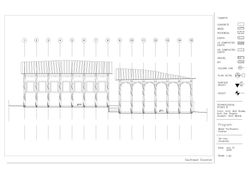Program
Planning a water purification facility that will make use of the Nyphea’s abilities to absorb heavy metals from water, while enriching the water with oxygen. The facility will be a modular structure, with each module taking part in the different stages of the purification process. In this project I will present the first-stage and last-stage modules.
The first-stage module collects the polluted water in an eco-pool where Nympheas are grown. The module’s envelope is sealed in order to prevent the exposure of visitants to reek and to avoid danger of falling into the pool.
The water is drained from one module to the next, while being purified by water plants during each stage.
The last module is open to its surrounding’s and it functions as an ornamental pool.
What is an Eco-pool?
An eco-Pool is a pool where water plants and kept-fish create an ecologic balance. In some pools, a filtering system assistance is required. A balanced pool is a pool in which the equilibrium between its various components is kept. The fish and the water plants nourish each other, and therefore in many cases there’s no need to feed the fish. Water plants play a vital role in purifying the water, by oxidizing the pool and by shading it. The pool is water efficient, it fights mosquitoes biologically, and in time, the need for maintenance declines due to the use of biological purification means. As the pool is established with vegetation growth, it creates a micro-climate which attracts wildlife such birds, invertebrates and more.
The Site
The structure is located in the botanical garden, on the eastern slope of Sheikh Mouneis ridge. The slope enables water flow without using mechanical pumping. Furthermore, due to reek coming from the wastewater flow, the structure is located far away from other buildings in the botanical garden.

Water plants
Water plants play a vital role in the eco-pool as they oxidize the water (all oxidizing plants are under water), and some planrs also shade the water and protect it from solar radiation. The Nymphea is a tuber plant which blossoms during springtime and summertime. Some Nympheas bloom during the day and some do so during the night.
Water plants can produce materials that interfere with pollutants growth in their surroundings. In addition water plants are strong rivals over light, nutrients and space in the pull.
Plans, Sections and Elevations
 |  |
|---|---|
 |  |
 |  |
Construction Stages

Pouring the reinforced concrete foundations

Laying the concrete beams and completion of the lower structural frame

Sealing the pools

Pouring the reinforced concrete foundations
Water plants function as an ecologic pesticides
 |  |
|---|---|
 |  |
 |  |
 |  |
 |  |
 |  |
 |  |
 |
Copper has many industrial and agricultural uses such as a pesticides against bacteria, fungus and seaweed. The many uses of copper salts such as Copper (II) sulfate, in the wood industry, in painting, in the chemical industry and in pesticides cause an accumulation of this heavy metal in natural environments and it also poisons wildlife and vegetation.
Water plants’ ability to absorb heavy metals from water can be used in two manners:
As indicators for infection and as water purifiers. Therefore, it is a favored non-polluting biological pesticide for sewage treatment.